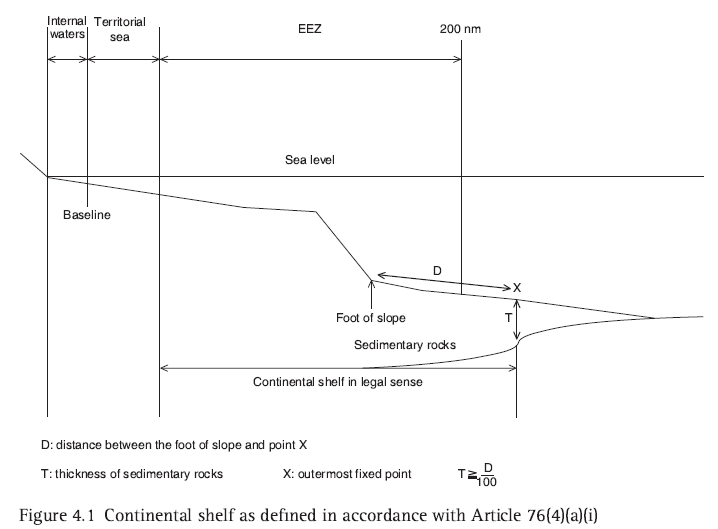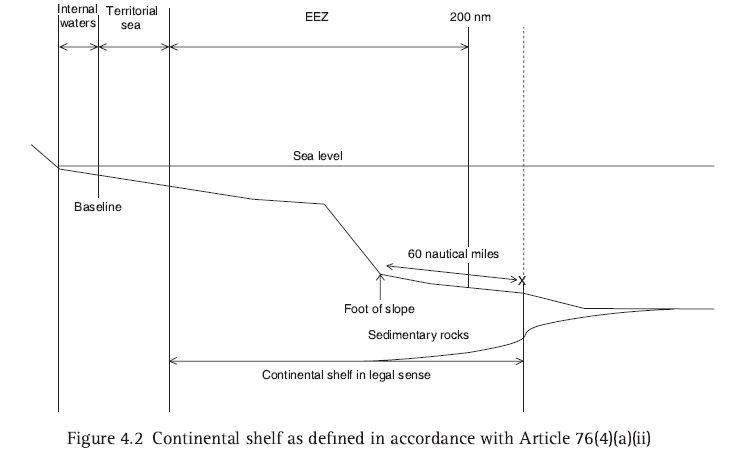Where the outer edge of the continental margin extends beyond 200 nautical miles, the limit of the continental shelf is to be determined on the basis of the geological criteria set out by Article 76(4). This provision contains two criteria for fixing the seaward limit of the continental shelf.
The first criterion is the sedimentary thickness test enshrined in Article 76(4)(a)(i). As this criterion was introduced by Ireland, this is called the Irish formula or Gardiner formula. According to this criterion, the outer edge of the continental margin is fixed by a line delineated by reference to the outermost fixed points at each of which the thickness of sedimentary rocks is at least 1 per cent of the shortest distance from such point to the foot of the continental slope. The sedimentary thickness test may provide a possible criterion to evaluate the presence or absence of hydrocarbon reserves. It may be said that this criterion seeks to reserve the right to exploit petrol for the coastal State.


A second criterion is the Hedberg formula provided in Article 76(4)(a)(ii). According to this formula, the outer edge of the continental margin is determined by a line delineated by reference to fixed points not more than 60 nautical miles from the foot of the continental slope. In the absence of evidence to the contrary, the foot of the continental slope shall be determined as the point of maximum change in the gradient at its base by conformity with Article 76(4)(b).
In either case, lines delineating the outer limits of the continental shelf must be straight lines not exceeding 60 nautical miles in length, connecting fixed points, defined by coordinates of latitude and longitude (Article 76(7)). The fixed points comprising the line of the outer limits of the continental shelf on the seabed shall not exceed 350 nautical miles from the baselines from which the breadth of the territorial sea is measured or shall not exceed 100 nautical miles from the 2,500-metre isobaths (Article 76(5),.
Furthermore, under Article 76(6), on submarine ridges, the outer limit of the continental shelf shall not exceed 350 nautical miles from the baselines from which the breadth of the territorial sea is measured, although this provision does not apply to submarine elevations that are natural components of the continental margin, such as its plateaux, rises, caps, banks and spurs. In addition, a specific method is to be applied in establishing the outer edge of the continental margins of these States in the southern part of the Bay of Bengal.
Presently the continental shelf beyond 200 nautical miles attracts many coastal States. Yet there is a concern that this regime reintroduces the inequalities between States which the uniform breadth of 200 nautical miles was supposed to remove. Further to this, the criteria set out in Article 76 give rise to a degree of uncertainty as to its practical application.
For instance, in the application of the Irish and the Hedberg formulae, the location of the foot of the continental slope is of primary importance. However, identifying the foot of the continental slope is not free from difficulty in practice. It is also suggested that the observed sediment thickness can be in error by as much as 10 per cent. If this is the case, this will have a significant impact upon the location of the outer limits of the continenta shelf. The points of the 2,500-metre isobath may also be difficult to locate when isobaths are complex or repeated in multiples. In light of the scientific uncertainties, the LOSC established a technical body which assesses data respecting the outer limits of the continental shelf, namely the Commission on the Limits of the Continental Shelf (hereinafter CLCS or the Commission).




